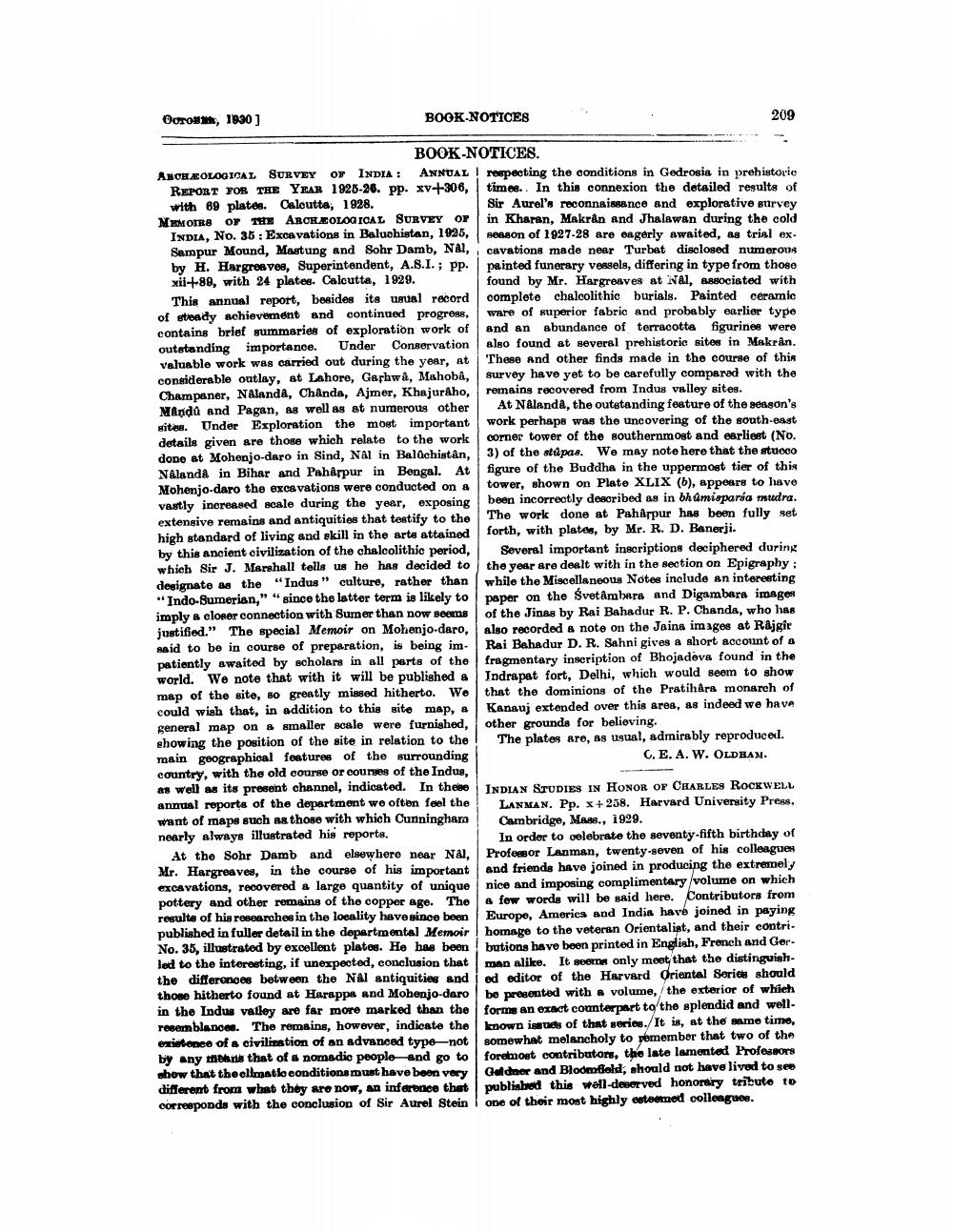________________
Oorom, 1930 ]
BOOK NOTICES
209
BOOK-NOTICES. AHOK XOLOGICAL SURVEY OF INDIA : ANNUAL respecting the conditions in Gedrosia in prehistorie
REPORT YOR THE YEAR 1928-26. pp. xv+306, time. In this connexion the detailed results of with 69 plates Calcutta, 1928.
Sir Aurel's reconnaissance and explorative survey MEMOIRS OF ME ABCHEOLOGICAL SURVEY OF in Kharan, Makrin and Jhalawan during the cold
INDIA, No. 35 : Excavations in Baluchistan, 1925, Henson of 1927-28 are eagerly awaited, as trial ex. Sampur Mound, Mastung and Sohr Damb, NAI,,cavations made near Turbet disclosed numerous by H. Hargreaves, Superintendent, A.S.I. ; pp. painted funerary vessels, differing in type from thoso xil+88, with 24 plates. Caloutta, 1929.
found by Mr. Hargreaves at NAI, Associated with This annual report, besides its usual record complete chalcolithic burials. Painted ceramic of steady achievement and continued progress, ware of superior fabric and probably earlier type contains brief summaries of exploration work of and an abundance of terracotta figurines were outstanding importance. Under Conservation also found at several prehistoric sites in Makran. valuable work was carried out during the year, At These and other finds made in the course of this considerable outlay, at Lahore, Gashwa, Mahoba, survey have yet to be carefully compared with the Champaner, Nalanda, Chánda, Ajmer, KhajurAho, remains recovered from Indus valloy sites. Manda and Pagan, as well as at numerous other At Nalanda, the outstanding feature of the season's sites. Under Exploration the most important work perhaps was the uncovering of the south-east details given are those which relate to the work corner tower of the southernmost and earliest (No. done at Mohenjo-daro in Sind, NAI in Balochistan, 3) of the atopas. We may note here that the stucco NalandA in Bihar and Paharpur in Bengal. At figure of the Buddha in the uppermost tier of this Mohenjo-daro the excavations were conducted on a tower, shown on Plate XLIX (b), appears to have vastly increased scale during the year, exposing! been incorrectly described as in bh Amisparía mudra. extensive remains and antiquities that testify to the The work done at PahAppur has been fully set high standard of living and skill in the arts attained forth, with plates, by Mr. R. D. Banerji. by this ancient civilization of the chalcolithic period, Several important inscriptions deciphered during which Sir J. Marshall tells us he has decided to the year are dealt with in the section on Epigraphy: designate as the "Indus" culture, rather than while the Miscellaneous Notes include an interesting "Indo-Sumerian," "since the latter term is likely to paper on the Svet Ambers and Digambara images imply a closer connection with Sumer than now seems of the Jinas by Rai Bahadur R. P. Chanda, who has justified." The special Memoir on Mohenjo-daro, I also recorded a note on the Jaina images at Rajgir said to be in course of preparation, is being im- Rai Bahadur D. R. Sahni gives a short account of a patiently awaited by scholars in all parts of the fragmentary inscription of Bhojadova found in the world. We note that with it will be published a | Indrapat fort, Delhi, which would seem to show map of the site, so greatly missed hitherto. We that the dominions of the Pratih ra monarch of could wish that, in addition to this site map, a Kanauj extended over this area, as indeed we have general map on a smaller scale were furnished, other grounds for believing. showing the position of the site in relation to the ! The plates are, as usual, admirably reproducel. main geographical features of the surrounding
C.E.A. W. OLDHAM. country, with the old course or courses of the Indus, 48 well as 100 procent channel, indicated. In these | INDIAN STUDIES IN HONOR OF CHARLES ROCKWELL annual reports of the department we often feel the
I LANMAN. Pp. x + 258. Harvard University Press, want of maps such as those with which Cunningham
Cambridge, Mass., 1929. nearly always illustrated his reports.
In order to oelebrate the seventy-fifth birthday of At the Sohr Damband elsewhere near Nal, Professor Lanman, twenty-seven of his colleagues Mr. Hargreaves, in the course of his important and friends have joined in producing the extremely excavations, recovered a large quantity of unique | nice and imposing complimentary/volume on which pottery and other remains of the copper age. The few words will be said here. Contributors from results of his researches in the locality have since been Europe, America and India have joined in paying published in fuller detail in the departmental Memoir ! homage to the veteran Orientalist, and their contri. No. 35, illustrated by excellent plates. He has been butions have been printed in English, French and Gerled to the interesting, if unexpected, conclusion that man alike. It seems only meet that the distinguish the differences between the Nål antiquities and ed editor of the Harvard Oriental Series should those hitherto found at Harappa and Mohenjo-daro be presented with a volume, the exterior of which in the Indus valley are far more marked than the forms an exact counterpart to the splendid and wellresemblance. The remains, however, indicate the known issues of that series. It is, at the same time, existence of a civilization of an advanced typenot somewhat melancholy to pemember that two of the by any than that of a nomadio people and go to foremost contributors, the late lamented Professors show that thoolimatlo conditions must have been very Geldner and Bloomfield, should not have lived to see different from what they are now, an infarbice that published this well-deserved honorary tributo to corresponds with the conclusion of Sir Aurel Stein one of their most highly esteemed colleagues.




